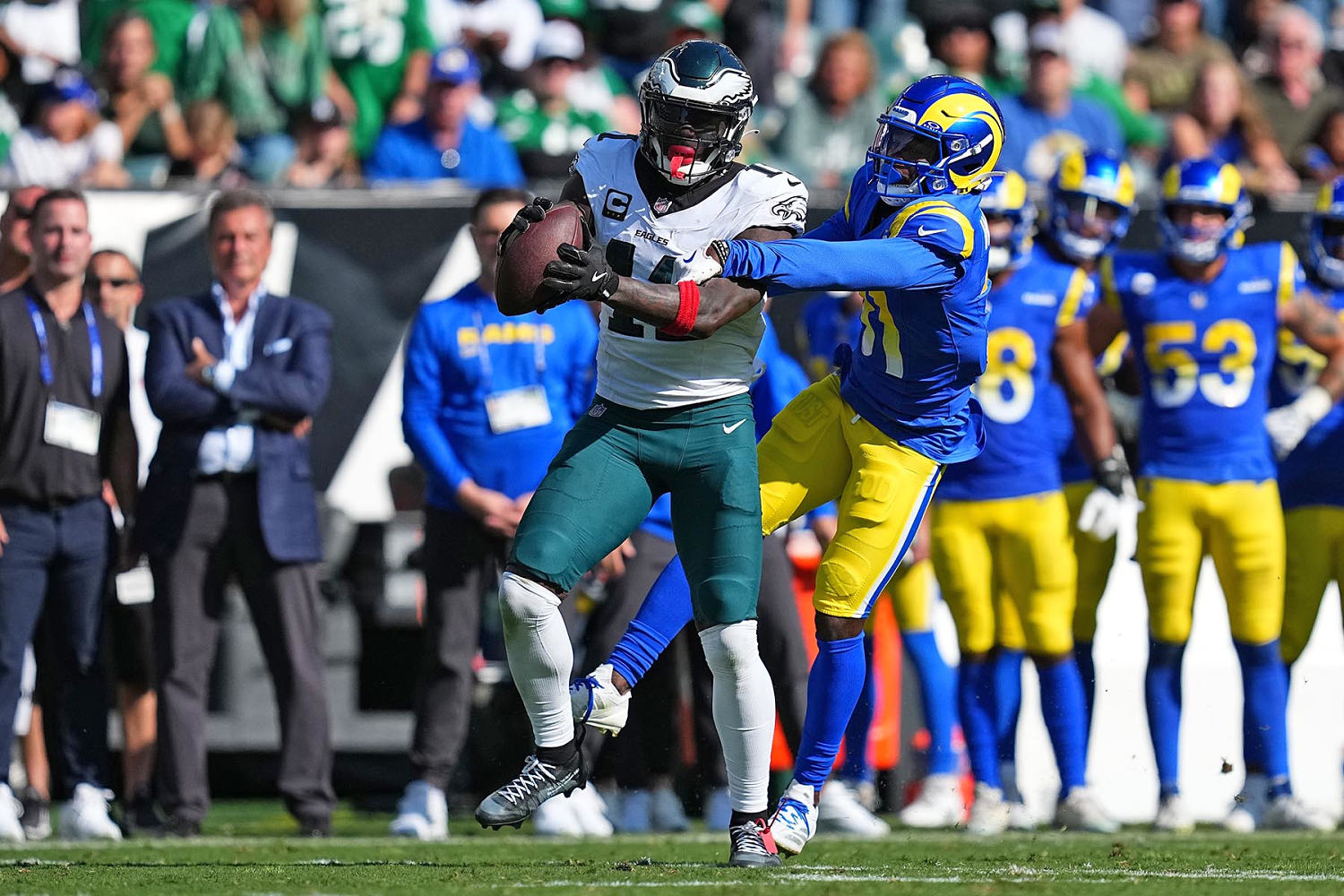Share this @internewscast.com

Just three plays into the second half, following a Jalen Hurts fumble, the Philadelphia Eagles found themselves trailing 26-7 against the Los Angeles Rams in their NFC championship game rematch. The lackluster offensive performance drew boos from the home crowd.
Whether spurred on by the dissatisfaction of the fans or a surge of urgency, the Eagles’ offense began to revive. Despite having averaged just 22 points per game in the initial two weeks of the season, Philadelphia’s offense managed to score 20 points in the second half alone, leading to a 33-26 victory.
And the key to scoring explosion was simple: Get the ball to receiver A.J. Brown.
Through their first 2½ games, the Eagles’ offense looked pretty mediocre despite their 2-0 record.
In the first two weeks, quarterback Jalen Hurts had thrown for only 253 yards with no passing touchdowns. His passing efficiency, averaging 5.6 yards per attempt, was even lower than Saquon Barkley’s 5.8 yards per carry rushing average in 2024.
Due to the weak passing game, Pro Bowl receiver Brown was not utilized effectively. Over the first two games, he caught only six of ten targets for 35 yards, and his average of 5.8 yards per catch was significantly lower than his career minimum of 13.7 yards per reception.
In the first half on Sunday, Philly’s offense somehow looked worse.
Hurts had completed just 4-of-8 passes for 17 yards, and including sacks, the Eagles had negative 1 yard in passing. (According to Sheil Kapadia from The Ringer, Philadelphia’s total of 33 yards was their lowest in a decade.) Brown, targeted once, caught no passes.
However, from their second drive of the second half, despite the absence of star right tackle Lane Johnson due to injury, first-year offensive coordinator Kevin Patullo started to call for deeper attempts, a strategy that ultimately succeeded.
Philly scored touchdowns on three of its final four possessions of the second half, all of which came via Hurts’ arm. He threw for 209 yards and three scores in the third and fourth quarters, leading the Eagles to 20 consecutive points. (Philly’s final touchdown came on a blocked field goal return as time expired.)
“We got so many good players on this team, and at times you can feel like we’re being conservative, and I don’t think it should be like that,” Brown told reporters after the game. “I think it should [be] let your killers do they thing and play fast and play aggressive. I’m not saying that we haven’t been, but for me personally, that’s what I would like.”
And after having thrown Brown’s way only once in the first half, Hurts threw him the ball nine times in the second. Brown finished with six catches for 109 yards and a touchdown. He matched his season reception total while eclipsing his yardage total in one half.
The key was finally pushing the ball upfield.
According to NFL Next Gen Stats, through the first 10 quarters of the season, Hurts had attempted only seven passes over 10 air yards, completing two. In the second half against the Rams. he threw nine passes over 10 air yards, connecting on seven for 154 yards and two touchdowns.
“We have pride in this win, as ugly as it was and as beautiful as it isn’t,” Hurts said after.
Are the Eagles’ offensive issues definitely fixed? One area of concern is the rushing attack, which is considerably less explosive than it was last season.
Through its Super Bowl run, Philly averaged 5.0 yards per carry a year ago, with Barkley alone rushing for over 2,000 yards. This season, the Eagles were averaging only 3.9 yards per rush entering Sunday — 20th in the NFL — and they managed only 3.2 yards per carry against Los Angeles.
“No victory Monday for us; we’re going to go back to work,” head coach Nick Sirianni said in his postgame news conference. “We do have a lot of things to clean up.”
Part of the issue might have been the team’s reluctance to test defenses deep through the air. If Philadelphia is finally committed to throwing the ball beyond the sticks — and getting it into the hands of one of its best players — the early season offensive lull may be coming to an end.













